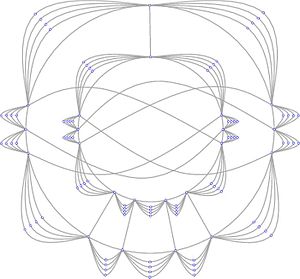Topological graph
(The term geometric graph is sometimes used in a broader, somewhat vague sense.)A fundamental problem in extremal graph theory is the following: what is the maximum number of edges that a graph of n vertices can have if it contains no subgraph belonging to a given class of forbidden subgraphs?The prototype of such results is Turán's theorem, where there is one forbidden subgraph: a complete graph with k vertices (k is fixed).Historically, the first instance of such a theorem is due to Paul Erdős, who extended a result of Heinz Hopf and Erika Pannwitz.[2] He proved that the maximum number of edges that a geometric graph with n > 2 vertices can have without containing two disjoint edges (that cannot even share an endpoint) is n. John Conway conjectured that this statement can be generalized to simple topological graphs.A topological graph is called "simple" if any pair of its edges share at most one point, which is either an endpoint or a common interior point at which the two edges properly cross.The first linear upper bound on the number of edges of such a graph was established by Lovász et al.[3] The best known upper bound, 1.3984n, was proved by Fulek and Pach.[5] A topological graph is said to be x-monotone if every vertical line intersects every edge in at most one point.Alon and Erdős[6] initiated the investigation of the generalization of the above question to the case where the forbidden configuration consists of k disjoint edges (k > 2).[10] This implies that every complete simple topological graph with n vertices has at leastFor any integer k > 1, a topological or geometric graph is called k-quasi-planar if it has no k pairwise crossing edges.It follows from Euler's polyhedral formula that every planar graph with n > 2 vertices has at most 3n − 6 edges.[16] It is also known to be true for convex geometric graphs (that is for geometric graphs whose vertices form the vertex set of a convex n-gon),[17] and for k-quasi-planar topological graphs whose edges are drawn as x-monotone curves, all of which cross a vertical line.[20] The best known general upper bound for the number of edges of a k-quasi-planar topological graph ispairwise crossing edges, which was improved to a quasi linear bound in the case of geometric graph.[22] Ever since Pál Turán coined his brick factory problem [23] during World War II, the determination or estimation of crossing numbers of graphs has been a popular theme in graph theory and in the theory of algorithms[24] that is abundant with famous long standing open problems such as the Albertson conjecture, Harary-Hill's conjecture[25] or the still unsolved Turán's brick factory problem.[26] However, the publications in the subject (explicitly or implicitly) used several competing definitions of crossing numbers.Crossing number (of a graph G): The minimum number of crossing points over all drawings of G in the plane (that is, all of its representations as a topological graph) with the property that no three edges pass through the same point.Rectilinear crossing number: The minimum number of crossing points over all straight-line drawings of G in the plane (that is, all of its representations as a geometric graph) with the property that no three edges pass through the same point.By definition, one has cr(G) ≤ lin-cr(G) for every graph G. It was shown by Bienstock and Dean that there are graphs with crossing number 4 and with arbitrarily large rectilinear crossing number.In traditional graph theory, a typical Ramsey-type result states that if we color the edges of a sufficiently large complete graph with a fixed number of colors, then we necessarily find a monochromatic subgraph of a certain type.[41] The existence of a non-crossing monochromatic path of size at least cn, where c > 0 is a constant, is a long-standing open problem.It is only known that every complete geometric graph on n vertices contains a non-crossing monochromatic path of length at leastThere are some initial results in this direction, but it requires further research to identify the key notions and problems.[43][44][45] Two vertex disjoint simplices are said to cross if their relative interiors have a point in common.A set of k > 3 simplices strongly cross if no 2 of them share a vertex, but their relative interiors have a point common.[47] If we forbid k strongly crossing simplices, the corresponding best known upper bound isIt is an old problem of Gil Kalai and others to decide whether the largest number of almost disjoint triangles that can be chosen on some vertex set of n points in
topological graph theorymathematicsverticesJordan arcsJordan curvesgeometric graphgraph theorycombinatorialgraph drawingextremal graph theoryTurán's theoremPaul ErdősHeinz HopfErika PannwitzJohn ConwaythrackleLovászErdősEuler's polyhedral formulaupper boundCrossing number (graph theory)Pál Turánhis brick factory problemWorld War IIcrossing numbers of graphsAlbertson conjectureTurán's brick factory problemCrossing numberHanani–Tutte theoremNP-completeCrossing Lemmagraph genusRamsey-type resultspanning treesimplicial complexTverberg theoremGil KalaiDiscrete and Computational GeometryHopf, HeinzPannwitz, ErikaLovász, LászlóPach, JánosSzegedy, MarioFulek, RadoslavDiscrete Applied MathematicsAmerican Mathematical MonthlyAlon, NogaErdős, PaulJournal of Combinatorial TheoryComput. Geom.AlgorithmicaAgarwal K., PankajAronov, BorisPollack, RichardSharir, MichaCombinatoricaFox, JacobSIAM Journal on Discrete MathematicsEuropean Journal of CombinatoricsTardos, GáborAdvances in MathematicsJournal of Graph TheoryGarey, M. R.Johnson, D. S.Electronic Journal of CombinatoricsDiscrete & Computational GeometryPach, J.Goodman, Jacob E.O'Rourke, JosephMatoušek, JiříDey, Tamal K.Canadian Mathematical BulletinSolymosi, József